The Insider
The greening of L.A.’s Civic Center
November 3, 2011
The giant yuccas haven’t moved in yet, and neither have the California Pepper, Japanese Pagoda or Strawberry Snowball trees.
But make no mistake, the downtown park project is definitely entering its green period.
The first trees are now taking root in the 12-acre expanse in the heart of the Civic Center—the first visible manifestation of the ambitious Grand Avenue Project intended to create a cultural and civic sense of place in downtown Los Angeles. Since July, 50 of 373 new trees have been planted, joining the 95 that were left in place on the site when work began in 2010. (Many of the new trees are varieties of palm, and there also are dozens of California sycamores and Tipuana tipu trees in the arboreal lineup, along with eight coast live oaks and a wide range of other varieties.) Landscaping on the project is expected to continue through next May.
The park, scheduled to open next summer, will represent a dramatic transformation of a once banal stretch of downtown public space, creating an “iconic” and “spectacular” gathering spot for diverse activities ranging from picnicking to big-screen musical simulcasts. Stretching in three sections from the Music Center to City Hall, the park’s ADA-accessible ramps will complement a series of stairs, terraces and lawns.
The tree planting has picked up pace lately. Newly-installed palm trees (some weighing 15,000 pounds each) and silvery-leafed olive trees are now ensconced near the park’s new Starbucks building (which adds its own blast of green to the landscape thanks to its bright chartreuse slanted roof.)
The Board of Supervisors this week approved an amended 10-year agreement with Starbucks increasing the company’s monthly rent to reflect the new, larger 1,195-square-foot space; it will go to $3,585, from $2,250. Since business is expected to increase once the new park is open, the county—which will receive 6% of the coffee concession’s annual gross sales above $717,000—anticipates that its take will go up as well. The total annual revenue for the county, including the rent, is projected to be about $70,800 a year, the report said
The current Starbucks, long a fixture of daily life for jurors and Civic Center employees, will be leveled when the new facility is ready for business.
Also coming down soon will be the wooden barricades and concrete “k-rail” barriers that have closed off the Grand Avenue end of the project for months. The Grand Avenue sidewalk, which also has been closed, will be reopened on Monday, November 14, along with a mid-block crosswalk that leads to the Music Center and the Grand Avenue ramps to the Hall of Administration parking lot.
Dawn McDivitt, who is overseeing the project for the county’s Chief Executive Office, said other signs of progress also are on the way. For example, she said, one of the park’s hallmark features, the restored Arthur J. Will Memorial Fountain, should be ready for testing around the first of the year.
“It is exciting to see many features of the park taking shape,” she said. Updated 11/10/11: See for yourself in the most recent construction photos from the site.
Posted 11/2/11
The last map standing
September 28, 2011
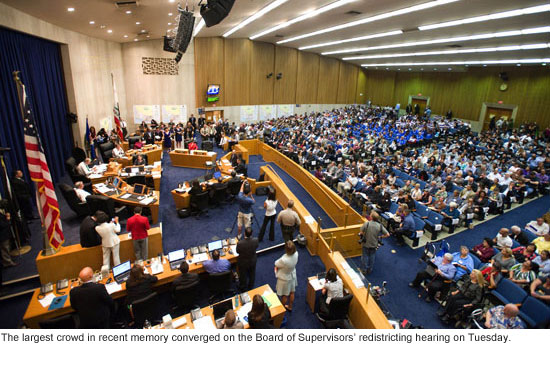 After weeks of robust debate that sparked thousands of letters, e-mails and public comments, Los Angeles County’s most contentious redistricting process in a generation came to a dramatic close Tuesday as supervisors voted 4-1 to approve new political boundaries that hew relatively closely to the current map.
After weeks of robust debate that sparked thousands of letters, e-mails and public comments, Los Angeles County’s most contentious redistricting process in a generation came to a dramatic close Tuesday as supervisors voted 4-1 to approve new political boundaries that hew relatively closely to the current map.
The supervisors voted after hearing six hours of public testimony from 243 speakers who invoked the history of Latinos in L.A., the meaning of changing demographics and sharply divergent opinions on whether “racially polarized voting” still exists in the county to such an extent that it denies Latinos an equal opportunity to elect a person of their choosing. Others asked supervisors to preserve existing “communities of interest” so that neighborhood priorities such as protecting the environment and building health care networks would not be jeopardized.
In approving the redistricting map known as A3, supervisors rejected competing proposals by Supervisors Gloria Molina and Mark Ridley-Thomas that had sought to create a second supervisorial district in which Latinos make up a majority of the citizen voting age population.
In an initial round of voting toward the end of Tuesday’s meeting, it became clear that none of the proposed maps would receive the 4-1 “supermajority” vote needed to pass. So, after a brief closed session and some minor amendments to the A3 plan offered by Supervisor Michael D. Antonovich, Ridley-Thomas signaled he would change his vote.
“There is a rather obvious lack of consensus on a map here today,” Ridley-Thomas said. With a possible legal challenge from the Mexican American Legal Defense and Educational Fund looming, he said he wanted to avoid a “potentially divisive delay” and to push the matter toward the “closure” of a federal court ruling on what the Voting Rights Act required.
While he said he still believed in the plans he and Molina had put forward, he said he wanted to avert “the unnecessary gamble of the uncertainty of an untested appeal process”—a reference to the special redistricting commission made up of the District Attorney, Assessor and Sheriff that would have stepped in to decide the matter if the five-member Board of Supervisors had been unable to muster four votes for any of the proposals. After Ridley-Thomas’ change of course, the board voted 4-1 in favor of the A3 plan, with Molina casting the dissenting vote.
Ridley-Thomas’ S2 map and Molina’s T1 proposal would have moved up to 3.5 million residents to new electoral homes and split the San Fernando Valley into three supervisorial districts instead of the current two. The plans drew strong reactions across the county, and were criticized as blatant gerrymandering by Supervisor Zev Yaroslavsky and others.
Knabe, in remarks before the vote, said that his A3 plan was the best way to ensure all groups in the county are well-represented. More radical boundary changes, he said, weren’t legally necessary and don’t reflect modern-day electoral realities.
“We cannot hold onto the past when we see clear illustrations of change with the election of minority candidates at every level of government,” Knabe said. “Hanging onto the legal battles of 20 years ago does nothing to move us forward…At the end of the day our job, as elected officials, is to represent all ethnicities, all people in Los Angeles County.”
Molina, however, in a presentation before the vote, contended that creating a second “meaningful Latino opportunity district” was required under the federal Voting Rights Act because of current demographics and a long history of bias.
“The legacy of Latino political exclusion and discrimination in L.A. County is so pervasive,” she said, “that it has affected not only the way Latinos and Latino candidates are perceived by non-Latinos but the way Latinos perceive their own ability to participate in the political process.”
Map A3, she said, waters down the voting strength of Latinos by creating a large Latino majority only in her 1st District while keeping their numbers to a third, or lower, in the other four districts. Latinos make up nearly 48% of the population countywide, and about a third of the county’s citizens of voting age.
Yaroslavsky kept his remarks brief, saying he had already written or said just about everything he needed to on the issue. But he thanked the community for what he called “this unprecedented turnout” and for the level of discourse throughout the process. “On the whole it was an elevated public testimony that we heard and it contributed to the public understanding … of what’s before us,” he said.
More than 900 people turned out for the meeting, arriving in the early morning, filling the board hearing room and spilling into three overflow rooms and a large white tent erected on the Hall of Administration lawn.
But by the time the final vote was taken just after 6 p.m., only a handful of spectators remained to witness the moment—the culmination of the once-every-decade process in which boundaries are redrawn to reflect U.S. Census data. (Click here for our story on the day-long civics lesson for hundreds of students who attended the meeting.)
The new district boundaries take effect in 30 days. Here are some of the changes in store forLos Angeles County under the plan:
More than 277,000 people will move to new districts, and several communities will get a new supervisor. Claremont, for instance, will move from the 5th District to the 1st. Santa Fe Springs will move from the 1st to the 4th.
Several other communities, now split between two supervisors, will be consolidated. The lake area of Silverlake will no longer be in the 3rd District, for instance; instead, the whole community will be drawn into the 1st District, as will all of Pico Rivera, Azusa and West Covina. Similarly, the 2nd District will encompass all of Hawthorne and all of Florence/Firestone, and the 4th District will include all of South Whittier and West Whittier/Nietos.
The San Fernando Valley will continue to make up more than 50% of the 3rd District’s electorate, and the 3rd District also will continue to represent the Westside, Hollywood and the Santa Monica Mountains. The 3rd District will lose 15,468 people, creating a district that is 45.8% white, 37.9% Latino, 11.1% Asian/Pacific Islander and 4% African American.
The population of voting-aged Latino citizens will fall in the 1st District from 63.3% of the electorate to 59.7%. In the 4th District, it will rise slightly from 31.6% of the electorate to 32.8%.
Asian Pacific Islanders, who had expressed concerns that redistricting would dilute their representation, will continue to be concentrated in the 1st, 4th and 5th Districts, with the highest concentration of voting-aged API citizens in the 1st District at 19%.
Population also will be more evenly distributed among the districts under the plan adopted Tuesday. Prior to A3’s approval, the largest district, the 5th, had 2,088,786 people, while the smallest, the 1st, had 1,893,001. That deviation, about 10%, will be reduced under the new plan to 1.57%.
Posted 9/27/11
A hearing—and a civics lesson, too
September 27, 2011
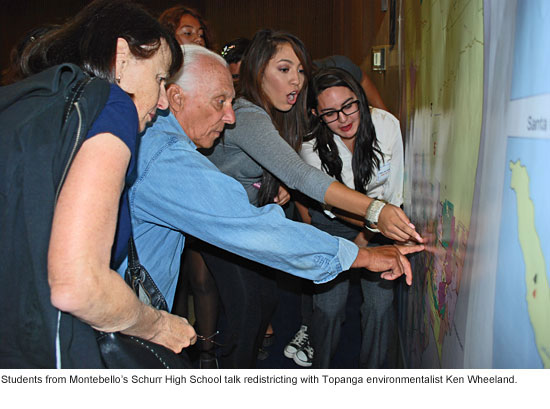 Hilda Placencia got a lesson in the complexities of political representation. Jesse Almaraz learned that government isn’t necessarily dull. Christopher Trujillo discovered that, when it comes to civic engagement, it helps to be a morning person.
Hilda Placencia got a lesson in the complexities of political representation. Jesse Almaraz learned that government isn’t necessarily dull. Christopher Trujillo discovered that, when it comes to civic engagement, it helps to be a morning person.
“We were the first ones into the building,” the 18-year-old El Monte student noted, planting himself in a choice seat in the Kenneth Hahn Hall of Administration. “But we had to be ready to go at 5:45 a.m.”
Tuesday’s public hearing on redistricting was many things to many people—a referendum on social justice, a call for a geographic balance of power, a refresher course on Los Angeles County’s shifting demography.
But for hundreds of adolescents packed into the audience—some bused in by community organizers, some carpooled in with their high school teachers—the marathon meeting was a daylong civics lesson.
“My teacher explained it to us, but this is explaining it better,” said Placencia, a 16-year-old senior (“Class of 2012!”) who was part of a contingent from Schurr High School in Montebello. “I learned more today here at this meeting than I did all day yesterday.”
More than 900 people showed up in the early morning to applaud, testify and otherwise weigh in on three rival plans for redrawing the county’s supervisorial boundaries. By the time the Board of Supervisors voted to adopt an amended version of plan A3, which mostly follows the current boundaries, it was dinner time.
But one of the most striking aspects of the crowd was its youth.
One section was packed with row upon row of students bused in from job training programs in Supervisor Don Knabe’s Fourth District. Another was filled with 50 blue-shirted teenagers and young adults who came from the San Gabriel Valley Conservation Corps in Supervisor Gloria Molina’s First District in a convoy of vans.
A classroom of students from Bell Gardens High School, escorted by Molina staff members, shuttled in and out, politely observing until mid-afternoon, when their school day ended; later, the supervisor—whose own Latino-majority district had been created as the result of a redistricting lawsuit—clambered onto a Roosevelt High School bus to thank still more young people for coming.
Teenagers being teenagers, of course, few could name their supervisors—a problem that afflicts some adults as well. But that didn’t dampen their interest. At one point, Placencia and a group of friends from Schurr High found themselves in a tutorial on how redistricting can affect environmental policies as well as ethnic power—a conversation that started when they found themselves seated next to Rosie Dagit, senior conservation biologist with the Resource Conservation District of the Santa Monica Mountains.
At Dagit’s suggestion, the students began examining wall maps delineating the proposals. Soon they were talking to Topanga environmentalist Ken Wheeland, who was sitting nearby. They listened attentively as Wheeland—his denim work shirt decorated with a small sage-green ribbon to demonstrate his concern for mountain preservation—explained that he feared the environment would take a backseat to commercial interests if the mountains were placed in the same district as the Ports of Los Angeles and Long Beach.
As their conversation wound down, Wheeland also shared some adult political perspective, saying that no matter what map won, “there’ll probably be a lawsuit and a judge will decide.”
The students then returned to their seats, periodically peppering Wheeland’s fellow environmentalist, Dagit, with questions as the surrounding crowd waved signs for the redistricting plan backed by Molina.
“I told them, ‘I’m not here to tell you what to think—you should make your own decisions, think about what’s important to you, look at the maps, listen to the testimony’,” Dagit reported. “About halfway through, three of them asked us for green ribbons.”
Elsewhere in the audience, 18-year-old art student Jesse Almaraz of Long Beach sketched as he listened to the proceedings. A student at Urban Arts Crew, a South Bay job training program supported by Knabe, Almaraz said he wanted his supervisor to remain the same.
“If our district were to change,” he said, “we might lose our funding. I’m all for equal representation or whatever, but I don’t feel that only Latinos can represent Latinos.”
What surprised him and his friends most, he said, was the vigor with which all the groups defended their positions.
“I thought this would be kind of a quiet thing but people keep making noise and shaking signs,” he marveled. “I wish we had some signs, man. That would be cool.”
Across the aisle,Trujillo and the Conservation Corps contingent stayed almost to the end of the proceedings.
“It’s a lot of information,” the teenager said. “But I’m learning a lot about what’s fair and what’s not fair. Some of it sounds right and some sound wrong, but I’m just gonna support Molina. I’m listening so I can prepare for the next time this comes around.”
And one bit of preparation he’d repeat, he said, was fortification for a long siege.
“Burritos and fruit snacks,” he recommended. “Stayin’ strong.”
Posted 9/27/11
Decision time for L.A. County
September 21, 2011
One way or another, history is likely to be made on Tuesday, September 27, at a momentous hearing to determine Los Angeles County’s political boundary lines for the decade to come.
Hundreds are expected to turn out for a final public airing of the competing redistricting plans that have sharply divided the Board of Supervisors in recent weeks. The plans known as T1 and S2 would radically redraw the boundary lines to create a district in which Latinos make up a majority of the citizen voting age population. The proposals would shift up to 3.5 million residents from their current electoral homes and split the San Fernando Valley into three districts instead of the present two. A third plan, A3, would keep current boundaries largely intact but still would reassign more than 277,000 people to new districts.
After the public has had its say during what is expected to be a spirited and long-running session Tuesday, it will be the supervisors’ turn to act. Their vote will represent a pivotal moment in the once-every-decade redistricting process in which supervisorial districts are rebalanced to incorporate population changes measured by the U.S. Census.
But it’s clear that this season of redistricting, aimed at evenly incorporating the 299,274 newcomers who arrived in Los Angeles County between 2000 and 2010, has been anything but a simple numbers exercise.
Board members must weigh an array of competing and compelling concerns—balancing issues of geography, community, ethnicity and race—and come together behind one of three proposed redistricting maps before October 1 in order to comply with the deadline established by the state Elections Code.
It’s a mark of the complexity of the debate that each of the three plans under consideration has a different supervisor behind it, with Gloria Molina backing T1, Mark Ridley-Thomas S2 and Don Knabe A3, while Zev Yaroslavsky has spoken out against T1 and S2 as a “bald-faced gerrymander” that needlessly breaks up communities. (Read his blog here.)
Because the County Charter requires the five-member board to pass a redistricting plan with at least four votes—not just a simple majority—the matter has the potential to veer off on an unprecedented course.
If four supervisors can’t agree on a plan by the deadline, then the decision would go before a special redistricting commission made up of District Attorney Steve Cooley, Assessor John Noguez and Sheriff Lee Baca. Although there have been hard-fought redistricting battles in the past, the “committee of three” apparently has never been called in to make the final call, said Martin Zimmerman, county assistant chief executive officer.
The state Elections Code specifies the composition of the panel and that the District Attorney serve as its chairman. In addition to the D.A., it mandates the participation of the assessor and a third elected official. Because Los Angeles County’s top elections official and school superintendent are appointed, the third slot here would fall to the sheriff, under the code.
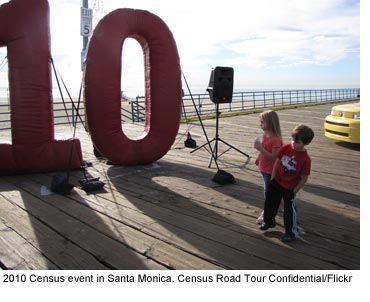 Much of the redistricting debate has hinged on exactly what is required under the federal Voting Rights Act, and whether there is “racially polarized voting” in the county. Courts have ruled that “50% districts”—those in which one minority group makes up more than 50% of the voting age citizenry—are required only when voting is so racially polarized that non-minorities vote against minority-preferred candidates so consistently that those candidates are denied an opportunity to win. That’s not the case here, opponents of the T1 and S2 maps say, because Los Angeles voters of all races have shown time and again that they will elect Latino candidates, including Los Angeles Mayor Antonio Villaraigosa, Sheriff Baca and Assessor Noguez.
Much of the redistricting debate has hinged on exactly what is required under the federal Voting Rights Act, and whether there is “racially polarized voting” in the county. Courts have ruled that “50% districts”—those in which one minority group makes up more than 50% of the voting age citizenry—are required only when voting is so racially polarized that non-minorities vote against minority-preferred candidates so consistently that those candidates are denied an opportunity to win. That’s not the case here, opponents of the T1 and S2 maps say, because Los Angeles voters of all races have shown time and again that they will elect Latino candidates, including Los Angeles Mayor Antonio Villaraigosa, Sheriff Baca and Assessor Noguez.
Despite that, advocates for the T1 and S2 proposals contend that racially polarized voting does exist here and that the county must respond to it by creating a second district with at least 50% Latino citizens of voting age. Latinos now make up 48% of the county’s overall population and about one-third of its citizens of voting age.
Adding to the complexity of the debate are concerns voiced by some Asian-Pacific Islander leaders who say the T1 and S2 proposals could seriously undercut their communities’ voting clout.
Then there are those who point out that, by law, race and ethnicity cannot be the only considerations in redistricting decisions.
Many of them, from neighborhoods across the county, turned out for a public hearing earlier this month to urge the Board of Supervisors to keep together existing “communities of interest” under the A3 plan in order to handle pressing regional issues such as transportation and the environment.
The outpouring at that hearing came as part of a redistricting process in which the public, for the first time, was invited to design and submit its own maps using a new county website. In all, 19 plans were submitted by individuals and organizations—16 of them using the software on the county site. The site, which also features thousands of letters from the public and a wealth of links to data and documents, has drawn nearly 48,000 visits since it was launched in March.
And the public’s participation is not over yet. The Board of Supervisors’ meeting begins at 9:30 a.m. on Tuesday, September 27, in Room 381 of the Hall of Administration, 500 W. Temple St. Those who can’t make it in person can still make their views known by emailing [email protected] or sending a letter to the Executive Office, Board of Supervisors, Room 383, Kenneth Hahn Hall of Administration, 500 W. Temple Street, Los Angeles CA 90012.
Viewers also will be able to tune in to the meeting via live webcast.
Posted 9/21/11
Three maps, many voices
September 7, 2011
Officially, three maps—two of which would radically reshape L.A. County’s political landscape—were at the heart of the Board of Supervisors’ public hearing on redistricting Tuesday.
But the day really belonged to the people, hundreds of them, who came to the Hall of Administration from all corners of the county to take a personal stand on what has become a highly political redistricting fight.
They packed the 690-seat board hearing room and at least 200 more crowded into two overflow rooms during the lively but generally good-tempered meeting. In all, 207 speakers, each allotted a minute to make their point, ended up addressing the Board of Supervisors during the marathon session. Their comments offered a dispatch from the front lines of governance, touching on everything from literally street-level services like traffic-slowing rumble strips on canyon roads to the very nature of representative democracy itself.
And many speakers, from many parts of the county, seemed to feel the same way as Malibu City Councilmember Lou La Monte, who told the board: “We ain’t broken. Please don’t fix us.”
“Anyone who lives here knows that the North Bay and South Bay have different interests,” La Monte said. “Maintaining as closely as possible the existing 3rd District lines would continue the success we have achieved working with our natural neighbors…Our present 3rd District works very well the way it is.”
The public hearing represented an important moment in the county’s once-a-decade redistricting process, in which the five supervisorial districts are rebalanced to reflect population changes measured by the U.S. Census. On Tuesday, many speakers favored map A3, which makes only modest changes to the current district boundaries, and opposed maps S2 and T1, which would dramatically redraw the lines and reassign more than 3 million residents in an effort to create a second supervisorial district in which Latinos make up a majority of the citizen voting age population. Both S2, submitted by Supervisor Mark Ridley-Thomas, and T1, proposed by Supervisor Gloria Molina, would divvy up the San Fernando Valley among three supervisors, instead of the two who share it now.
“While I’m proud of my culture and my heritage, I am torn between two lovers today,” said Sylmar resident and community activist William “Blinky” Rodriguez, who said he’d decided to side with his current supervisor, Zev Yaroslavsky, in the redistricting showdown. He credited Yaroslavsky and his staff with years of commitment to the northeast San Fernando Valley, with its large Latino population, and said: “I’m here to support not breaking up the San Fernando Valley, not breaking up the 3rd District.”
Yaroslavsky, who is in his final term as a county supervisor and thus not personally affected by the proposals, has strongly objected to the S2 and T1 plans as needlessly disruptive and damaging to communities throughout the county. (Read his blog here.)
Some 3rd District residents said they fear that the sweeping redistricting proposals would sweep away years of environmental progress.
“I haven’t heard enough here today about the Santa Monica Mountains National Recreation Area,” said one speaker, Bruce Benson. “It’s the largest urban national park in America. T1 and S2 will slice and dice this national treasure. Without A3, the wealthiest and most influential among us will move in to develop the mountains. Without A3, the bulldozers are on their way.”
Supervisor Don Knabe, who is up for re-election next year in a district that would be profoundly transformed under either the S2 or T1 plan, came in for vocal praise from many of his constituents, who turned out to support his A3 plan and advocate for keeping the 4th District largely intact.
“He is our hero,” said one speaker, Robert Thome of Whittier, a patient at Rancho Los Amigos Hospital in Downey.
Some who showed up to support Knabe’s A3 plan wore black T-shirts from the Energy Pathway Program at the South Bay Center for Counseling. Others, from communities linked by the Santa Monica Mountains, wore green ribbons. Both factions stood and waved together when their favored plan was mentioned.
On the other side of the issue, supporters raised signs reading “Follow the numbers…Follow the law!” when speakers advocated the S2 and T1 plans. Some also praised Molina as a trailblazer whose presence on the board grew out of a redistricting battle two decades ago.
“Twenty years ago, it took a court case to create the district that we now have [represented by Supervisor] Gloria Molina,” said Andre Quintero, mayor of El Monte. “This is one of those last legacy issues where you can create a district that not only gives Latinos an opportunity for another position here on the Board of Supervisors, but will create a huge impact for the county.”
“I urge you not to turn back the clock. Support two Latino districts,” added Jesus Andrade, of the National Council of La Raza.
Latinos make up 48% of the county’s overall population, and about one-third of its citizen voting age population. The federal Voting Rights Act requires equal opportunity for minority groups. However, courts have ruled that “50% districts”—those in which one minority group makes up more than 50% of the voting age citizenry—are required only when voting is so racially polarized that non-minorities vote against minority-preferred candidates so consistently that those candidates are denied an opportunity to win.
One speaker, George Brown, a Gibson Dunn attorney who served as voting counsel to the statewide Citizens’ Redistricting Commission, told the board that studies have found evidence of “racially polarized voting” among Latino and non-Latino voters in Los Angeles County.
But others argued that county voters have demonstrated they will vote for Latino and other minority candidates without the need for such dramatic boundary changes.
“To say that we need more Latino elected officials in our area is ridiculous,” said Alina Mendizabal, a community activist in Sylmar.
“Please. You don’t know our neighborhood. If you knew the San Fernando Valley, you’d know we already have tons of [Latino] elected officials.”
“We already have equality in our county,” added Mario Guerra, a city council member in Downey. “I’m insulted that anyone would suggest that in our particular city that we vote by the color of the skin or somebody’s surname…Let’s not move 3 million people around. Representation, not race.”
Other speakers expressed concerns that the Asian-Pacific Islander community would lose out under S2 and T1. “As we all know, L.A. County is one of the most culturally diverse places in the world, and the current 4th District boundary is well-balanced with diverse people from the white, Latino, African America, Asian American and other minority groups,” said Kimthai Kuoch of the Cambodian Association of America. ”Under plan S2 and T1, millions of people will be shifting and it will dilute our voting voice to almost nonexistent.”
Beyond questions of race and representation, the afternoon-into-evening session also offered a vivid look at how geography can be destiny—for better or worse.
People from communities in and around the Santa Monica Mountains, for example, worried that proposed boundary changes could have a negative effect on everything from land use to water quality to emergency preparedness.
And some feared the loss of long-running alliances.
“The city of Santa Monica currently has a number of regional issues, including homelessness, the environment, transportation, all of which are being addressed on a regional basis through our long-standing ability to work with our neighbors,” said Gleam Davis, mayor pro tem of Santa Monica, who said she was speaking as an individual citizen. “If our neighbors become very distant, such as in Long Beach, it will be much more difficult to find that community of interest and more difficult for us to meet the needs of our own constituents.”
Davis, a former trial attorney in the Justice Department’s Civil Rights division, said she believes the board “can meet both the letter and spirit of the Civil Rights Act and the Voting Rights Act by still maintaining the communities of interest that have been developed over the past few decades. It would be a shame to unravel the very important and powerful relationships that we have formed over the past decades by changing so many people and moving them around.”
The Board of Supervisors will hear a final round of public comments on the redistricting proposals on Sept. 27 and are expected to take a vote that day. If supervisors can’t pass one of the plans with a 4-1 margin, a special redistricting commission made up of District Attorney Steve Cooley, Sheriff Lee Baca and Assessor John Noguez will choose a plan.
Posted 9/7/11
From typist clerk to the top at DPSS
August 17, 2011
It’s funny how the little things can shape a working life.
Like that summer day in 1967 when Sheryl Spiller, fresh out of Centennial High School, went downtown to the county Hall of Administration with some girlfriends looking for summer jobs.
“I didn’t want to work for the county. But I didn’t want to wait outside either!” So Spiller went inside, aced the test and set off on a county career that has taken her from typist clerk to acting department head.
Spiller is taking the reins of the Department of Public Social Services from Philip Browning, recently named to temporarily head the troubled Department of Children and Family Services.
She’s not sure how long it will last, but it’s all happened so fast that “I don’t have time to fret over it,” she says.
Fretting doesn’t seem to be part of her make-up, in any case.
She’s built her career with a combination of front-line work, strategic savvy and a commitment to helping those around her grow on the job. And with more than three decades of DPSS service under her belt, there’s not much she doesn’t know about the department she’s been chosen to temporarily head.
“Staff jokes about not being able to get stuff by me. I’ve been there, done that,” says Spiller, the agency’s chief deputy director until her temporary appointment this week. Except for 3½ years in the county’s Child Support Services Department, where she first worked with Browning, her entire career has been within DPSS.
Browning calls her “an amazing lady” who’s been generous with her deep knowledge of the department and its people. “I think it’s remarkable that an individual could remain within one organization and have that kind of a presence and an impact,” he says.
“She’s a true, genuine leader,” adds a former boss, Joseph Guerra, now retired as the department’s assistant director. He credits her with a number of innovative contributions, including a pioneering outreach campaign to enroll uninsured children in the Healthy Families program—part of a larger initiative she headed to sign up more than 100,000 kids for Medi-Cal.
Spiller doesn’t foresee any big change of course for DPSS on her watch.
But her own role will be turned inside out.
Accustomed to working behind the scenes, Spiller now will be a more visible presence—front-woman for an agency charged with serving millions of the county’s neediest residents with programs including CalFresh (formerly known as food stamps), in-home services for the elderly and disabled and general relief assistance.
“I’ve always been the person on the inside, always had a focus on our human resources. Philip’s always been the public face of the department…I am going to have to make that shift,” she says.
Ever-shifting career challenges have had a way of turning out well for Spiller. “I would volunteer for everything, wherever the jobs were. I took some of the worst assignments.”
That included a stint at a welfare office then known as the “Unattached Men’s Center” in downtown Los Angeles, where female employees were rare at the time and the district director’s office featured a collection of knives and guns confiscated from the clientele.
“It was a really rough area,” she says. But “I didn’t even think about being afraid.”
She fondly remembers her time working at the DPSS facility nicknamed “The Pink Palace” (the name, and the colorful paint job, have passed into history but the office is still there, at Adams and Grand.) After that, she ran a section charged with coming up with innovations, such as simple, illustrated customer comment cards, that are still in use today. “It gave me an opportunity to be creative,” she says.
Her toughest challenge—although ultimately one of her most rewarding assignments—was going into the Compton office as its district director in the early ‘90s. She had to clean house; among other things, several employees were arrested on drug charges after a sheriff’s surveillance operation. And then there were those bullet holes in her office window—the consequence of being in what was then an active border area for three gangs. Internal Services Division came to the rescue with bullet-resistant glass. “Sheryl, it’s not bullet-proof,” they told her. “But it’ll slow it down.”
Working within a large organization to get things done—like knowing who to call to get those windows fixed quickly—goes along with Spiller’s broader philosophy of networking, educating and mentoring.
Whether setting up an on-premises program for employees in Compton to get their associates’ degrees or working actively with the county’s Management Council to help other managers hone their skills, Spiller says her “personal goal is to leave the department with highly educated, well-trained, success-oriented, self-motivated and healthy employees.”
She’s aware that her own professional narrative is an asset. Her rise from the clerical corps to the top ranks of management reads like a textbook case study, and in fact, a step-by-step account of it appeared in a workforce development publication put out as part of a collaboration between the county and the SEIU local representing many of its workers.
Spiller, 61, still keeps in touch with her old high school principal, who had counseled her to jump on the county track and get her college degree while she worked. (She ended up getting three, including a master’s in human resources and organization development from the University of San Francisco.)
She recently got on the phone to share with him the news of her most recent career move, to acting head of the agency where she’d started as a typist clerk back in ‘67.
“You won’t believe this,” she said, “but remember that advice you gave me 40 years ago? Well, it paid off.”
Posted 8/17/11
Local libraries get their groove back
August 15, 2011
Move over, iTunes.
On July 1, the public libraries for the county and city of Los Angeles will introduce Freegal (as in “free and legal”), a new online service for library members that offers them 13 free music downloads a month from Sony Music’s vast catalog of recorded music by legendary artists in every style and discipline.
The artist roster ranges from rock ’n’ roll pioneers like Gene Vincent and Roy Orbison through classic rock legends Bob Dylan and Bruce Springsteen to more contemporary talent like Foo Fighters, Beyoncé and Pitbull. Not to mention a rich catalogue of classical, jazz, show tunes and international music.
The arrangement was made possible through an innovative agreement with Library Ideas, a Fairfax, Virginia-based new media company that licenses and distributes music, games and language-learning materials through public libraries.
Together, the County Library and City Library systems negotiated a packaged deal with the company for a pair of individual one-year subscriptions, one for each institution. Library Ideas in turn has negotiated a fee arrangement with Sony Music for access to their catalogue for city and county library patrons, who will be permitted three downloads per week for the term of the subscription. Other clients include libraries in Connecticut, New Jersey, Florida, Arizona and Tennessee.
“We’ve known for a long time that the music industry is moving toward electronic music. This is a way for us to access that and provide a service to the public, but not just any service, a high demand service,” said County Librarian Margaret Donnellan Todd.
“Music,” she added, “is as important to culture as literature, film, fine art and the performing arts. So it makes sense to offer this service since it fits our mission of providing the community with culturally significant information resources.”
Between them, the two library systems serve a combined jurisdiction of nearly eight million residents in the City of Los Angeles and 51 of the County’s other 87 incorporated cities. The County library boasts a 7.7 million volume book collection, as well as magazines, newspapers, microfilm and other holdings – not to mention downloadable audiobooks, e-books and coming soon, music. For more information on these and many other services, visit the County Library and City Library websites.
Posted 6/30/11
The Browning of DCFS
August 10, 2011
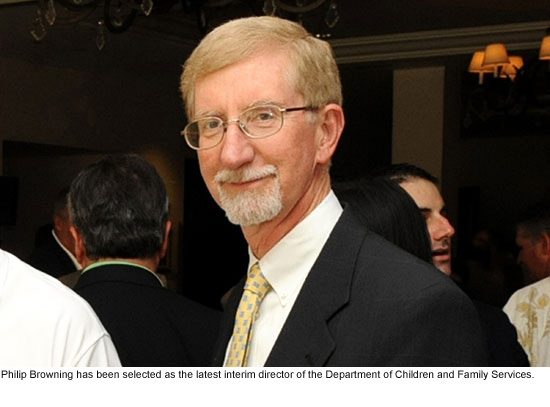 Philip Browning’s wife was, to put it kindly, skeptical when her husband told her that he’d been tapped to temporarily take control of Los Angeles County’s deeply troubled Department of Children and Family Services. “Why,” she asked, “would you want to take on a situation like that?”
Philip Browning’s wife was, to put it kindly, skeptical when her husband told her that he’d been tapped to temporarily take control of Los Angeles County’s deeply troubled Department of Children and Family Services. “Why,” she asked, “would you want to take on a situation like that?”
After all, Browning had emerged as one of the county’s most innovative and effective executives while running the huge Department of Public Social Services, which provides safety-net services for more than 2.6 million people on the economic margins of society.
Browning’s answer to his wife, who used to be a child protective services worker, was simple and direct: he was jumping into the DCFS pressure cooker because the Board of Supervisors asked him to do so.
“I was in the military for a long time and was accustomed to being asked to do things not entirely of my own choosing,” says Browning with a hint of his Southern gentility. “I think I have a sense of obligation.”
With the board’s official and unanimous vote for Browning this week, he becomes DCFS’ third interim director in the past nine months, following the dismissal of permanent chief Trish Ploehn amid an uproar over a number of high-profile child deaths and questions about the department’s forthrightness.
Browning was selected by board members who’d grown so dissatisfied that they retook control of the department’s management several months ago from the chief executive office, which had been given that responsibility as part of a sweeping remake of county government in 2007.
Although Browning is an interim director, the board has made it clear that they do not want just a seat-warmer while a search is underway for a permanent boss. He is empowered to take the actions necessary to improve the agency’s performance, as he has done at DPSS, making it among the nation’s leaders in serving its clients.
Whether at DPSS or DCFS, Browning says he offers a consistent approach. “The goal is to hire qualified people, get them trained and hold them accountable.” He says he knows that, for some managers, that final piece—accountability—can be uncomfortable.
“It’s tough to take the difficult disciplinary actions. We let people stay in positions where we know they should be moved,” says Browning, recalling times that he’s recommended the dismissals of longtime DPSS employees for violating client confidentiality or committing other serious transgressions.
That said, Browning is known as a team builder—more inclined to motivate than criticize. He also is legendary for his reliance on statistics to gauge an operation’s effectiveness. “Without good data,” he says, “you can’t change a program.”
At DPSS, he says, “we measure everything that is possible to be measured.” Those numbers are then analyzed monthly in a formal setting by managers.
“When I first came to DPSS, it was a very scary process,” Browning says of those sessions. “People would throw up before the meeting. The prior administration was more into criticism. It put too much stress on our employees. I just changed the focus. I told them we are all in this together. Let’s share our secrets of success. Let’s don’t try to be so competitive.”
Late Tuesday, after the board’s vote, Browning sent a memo to DCFS employees. He knows that some of them undoubtedly will be questioning the wisdom of selecting someone not currently immersed in Los Angeles’ child welfare system.
So he wrote of his masters of social work degree and the many years he spent in human services in Alabama and later in Washington, D.C. He recounted his 2001 hiring to turnaround a Los Angeles County District Attorney operation that had been widely criticized for failing to aggressively obtain child support money from so-called deadbeat dads. As the first director of child support services, his office increased collections 36% to $500 million and, he wrote, “moved the agency from a law enforcement system to a human services culture with a priority on customer service.”
Then, after talking about his belief in data, accountability and wellness programs (“I ran my five miles today,” he noted), Browning closed by saying that “the work performed by DCFS is some of the most challenging in America and…will certainly be a challenge to me.”
“I need your help and support.”
Posted 8/10/11
The patron saint of…government?
June 16, 2011
Los Angeles County’s top auditor, Wendy Watanabe, thought it had to be a joke or a scheme. At a time when government has come under the public lash, who would mail a $10,000 cashier’s check to the County of Los Angeles—especially someone in Washington State?
And who, in an accompanying note, would write something like this?: “In this time of economic difficulties, governments need all the help they can get. Please put this anonymous check to good use. God bless you.”
Given such unusual circumstances, Watanabe and her staff figured that the check might be counterfeit; the office has had some experience with that kind of thing in the past. But then, remarkably, it cleared the bank.
“We were elated that there would be such a good person out there,” said Watanabe. “Most of the time we get attacked for overspending. For someone to actually donate to the government, it’s just unheard of.”
“Why this person picked L.A. County, we have not a clue,” she added. “Maybe they’ve sent $10,000 to every government agency out there.”
For now, because of bank confidentiality rules, there’s no way to know much beyond the basics. The check was mailed directly to the Auditor-Controller’s Office. It was purchased at Banner Bank on May 2 and lists a toll free number in Walla Walla, Wash. A bank representative, contacted by a writer for Supervisor Yaroslavsky’s website, would reveal only that the transaction occurred at a branch in the town of Bellingham, about 90 miles north of Seattle. The branch employee who issued the check did not return several phone calls.
Every year, the county receives thousands of dollars in donations of various sorts, some of which are bequeathed in wills. For the most part, however, the recipients are specified, Watanabe says, with the lion’s share of money going to departments that deal with young people, such as children’s services and probation.
“Very rarely,” she says, “do we get a donation to a bunch of accountants and auditors. It’s a good feeling that they trust us.”
Unless the Board of Supervisors directs otherwise, Watanabe says, the money will be deposited in the county’s general fund.
Posted 6/16/11







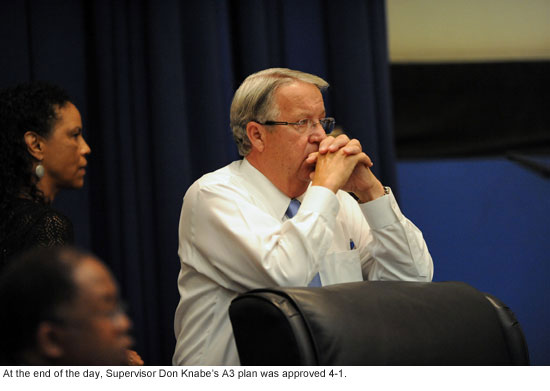


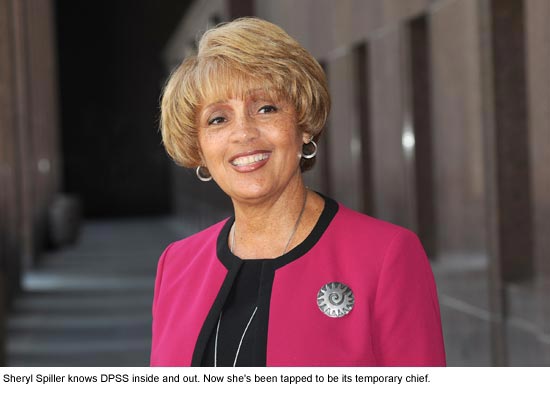









 405 bridge work causes a stink
405 bridge work causes a stink
